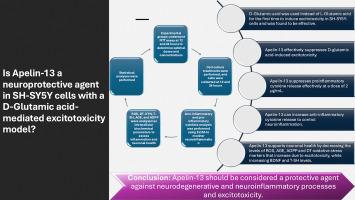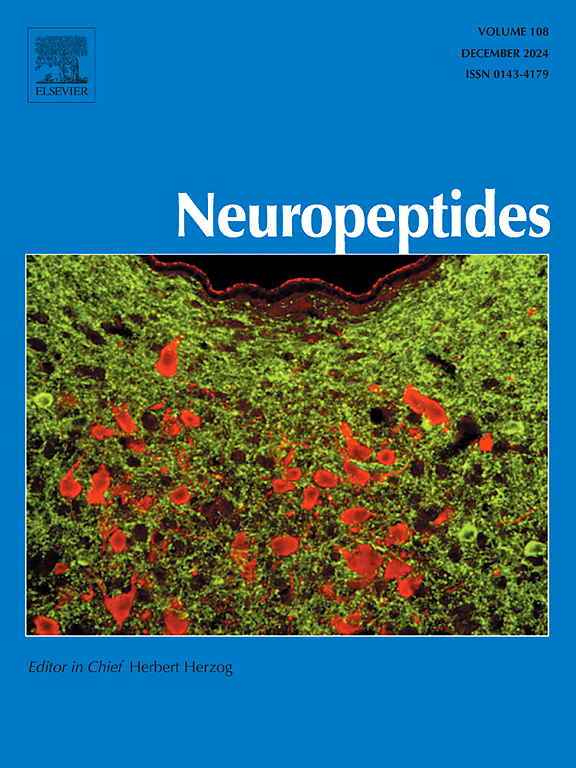Protective effect of Apelin-13 on D-glutamic acid-induced excitotoxicity in SH-SY5Y cell line: An in-vitro study
IF 2.7
3区 医学
Q3 ENDOCRINOLOGY & METABOLISM
引用次数: 0
Abstract
Excitotoxicity, resulting from excessive accumulation of glutamate in the extracellular space, leads to neuronal cell death. This study investigates the protective effects of Apelin-13 on D-Glutamic acid-induced excitotoxicity in SH-SY5Y human neuroblastoma cells, an in-vitro model for neurodegenerative diseases. Unlike the commonly studied L-glutamic acid, this research focuses on D-Glutamic acid to understand its specific impacts. SH-SY5Y cells were treated with varying concentrations of D-Glutamic acid and Apelin-13, followed by analyses at 12 and 24 h to evaluate cell viability, oxidative stress markers, and inflammatory cytokine levels. Cell viability assays revealed significant cytotoxic effects of D-Glutamic acid at doses of 10 mM and 20 mM, reducing viability by over 50 %. However, Apelin-13 treatment mitigated these effects, especially at 2 μg/ml, enhancing cell viability and reducing inflammatory cytokine levels (IL-1β and TNF-α). Apelin-13 also increased anti-inflammatory cytokine levels (IL-10 and TGF-β1) and brain-derived neurotrophic factor (BDNF), indicating its neuroprotective role. Oxidative stress markers, including ROS, AGE, AOPP, DT, T-SH, were significantly elevated by D-Glutamic acid but effectively reduced by Apelin-13. The neuroprotective mechanisms of Apelin-13 involve modulation of cAMP/PKA and MAPK signaling pathways, enhancing BDNF synthesis and suppressing oxidative stress and inflammatory responses. This study is the first to demonstrate the effects of D-Glutamic acid on SH-SY5Y cells. It highlights Apelin-13's potential as a therapeutic agent against excitotoxicity-induced neuronal damage, emphasizing its ability to modulate key molecular pathways involved in inflammation and oxidative stress. Further in-vivo studies are warranted to explore the long-term neuroprotective effects of Apelin-13 in treating neurodegenerative diseases.

Apelin-13对D-谷氨酸诱导的SH-SY5Y细胞系兴奋毒性的保护作用:体外研究
谷氨酸在细胞外空间的过度积累会导致兴奋性中毒,从而导致神经细胞死亡。本研究调查了 Apelin-13 对 D-谷氨酸诱导的 SH-SY5Y 人类神经母细胞瘤细胞兴奋毒性的保护作用,SH-SY5Y 人类神经母细胞瘤细胞是神经退行性疾病的体外模型。与通常研究的 L-谷氨酸不同,本研究侧重于 D-谷氨酸,以了解其具体影响。用不同浓度的 D-谷氨酸和 Apelin-13 处理 SH-SY5Y 细胞,然后在 12 和 24 小时后进行分析,以评估细胞活力、氧化应激标记物和炎症细胞因子水平。细胞活力测定显示,剂量为 10 毫摩尔和 20 毫摩尔的 D-谷氨酸具有明显的细胞毒性作用,可使细胞活力降低 50%以上。然而,Apelin-13 处理可减轻这些影响,尤其是在 2 μg/ml 剂量时,可提高细胞活力并降低炎性细胞因子水平(IL-1β 和 TNF-α)。Apelin-13还能提高抗炎细胞因子(IL-10和TGF-β1)和脑源性神经营养因子(BDNF)的水平,表明其具有神经保护作用。氧化应激标志物,包括 ROS、AGE、AOPP、DT、T-SH,在 D-谷氨酸的作用下显著升高,但 Apelin-13 能有效降低这些标志物。Apelin-13的神经保护机制包括调节cAMP/PKA和MAPK信号通路,促进BDNF合成,抑制氧化应激和炎症反应。这项研究首次证明了 D-谷氨酸对 SH-SY5Y 细胞的影响。该研究强调了 Apelin-13 作为一种治疗剂来对抗兴奋性毒性诱导的神经元损伤的潜力,并强调了其调节参与炎症和氧化应激的关键分子通路的能力。有必要进一步开展体内研究,探索 Apelin-13 在治疗神经退行性疾病方面的长期神经保护作用。
本文章由计算机程序翻译,如有差异,请以英文原文为准。
求助全文
约1分钟内获得全文
求助全文
来源期刊

Neuropeptides
医学-内分泌学与代谢
CiteScore
5.40
自引率
6.90%
发文量
55
审稿时长
>12 weeks
期刊介绍:
The aim of Neuropeptides is the rapid publication of original research and review articles, dealing with the structure, distribution, actions and functions of peptides in the central and peripheral nervous systems. The explosion of research activity in this field has led to the identification of numerous naturally occurring endogenous peptides which act as neurotransmitters, neuromodulators, or trophic factors, to mediate nervous system functions. Increasing numbers of non-peptide ligands of neuropeptide receptors have been developed, which act as agonists or antagonists in peptidergic systems.
The journal provides a unique opportunity of integrating the many disciplines involved in all neuropeptide research. The journal publishes articles on all aspects of the neuropeptide field, with particular emphasis on gene regulation of peptide expression, peptide receptor subtypes, transgenic and knockout mice with mutations in genes for neuropeptides and peptide receptors, neuroanatomy, physiology, behaviour, neurotrophic factors, preclinical drug evaluation, clinical studies, and clinical trials.
 求助内容:
求助内容: 应助结果提醒方式:
应助结果提醒方式:


